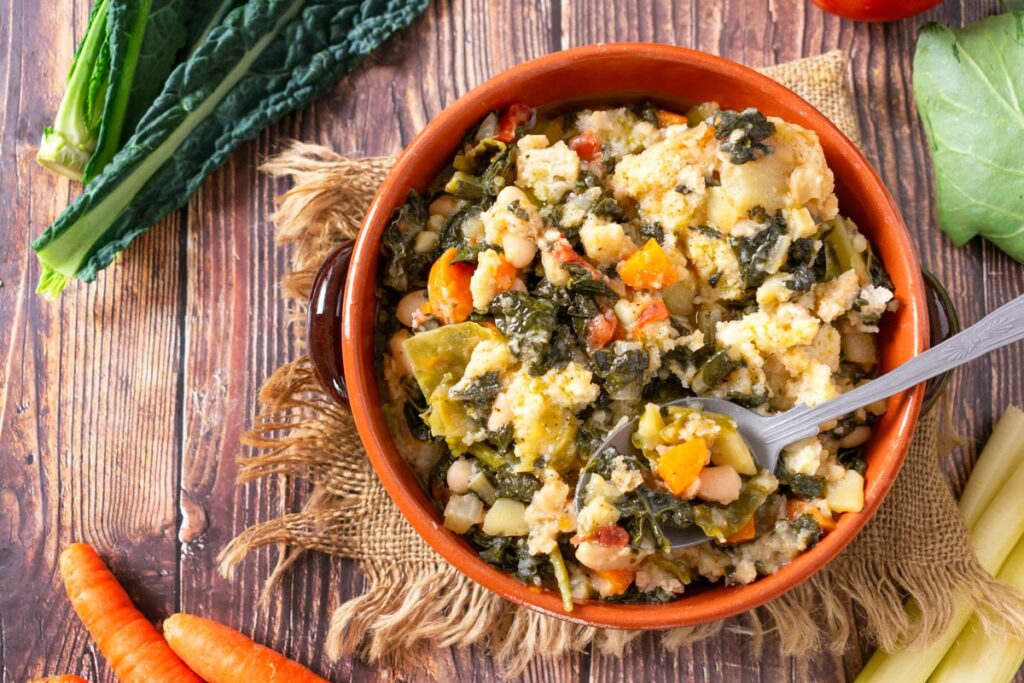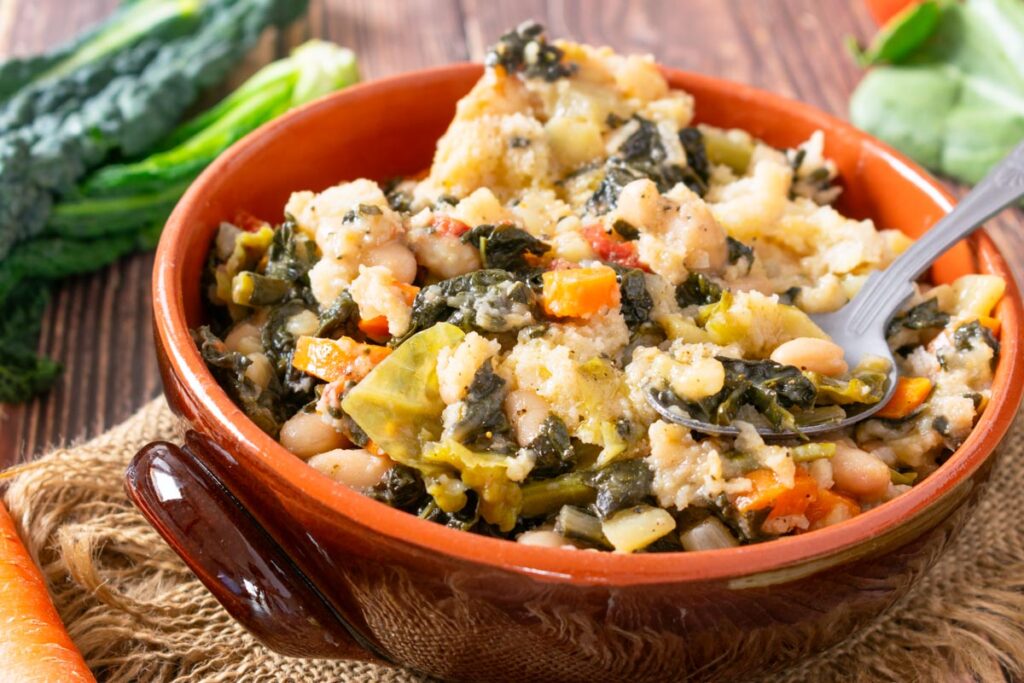Learn how to make authentic Ribollita, a hearty Tuscan soup with veggies and bread. This comfort food has deep roots and amazing flavor.
If you’re seeking to master the art of authentic Tuscan cuisine, look no further than the iconic Ribollita soup. This hearty, vegetarian dish has deep roots in Tuscan culinary tradition, originating as a humble meal for the region’s poorest inhabitants. Today, Ribollita has gained worldwide acclaim while maintaining its rustic charm. As you embark on this culinary journey, you’ll discover how simple ingredients like cavolo nero, cannellini beans, and unsalted Tuscan bread combine to create a dish that has stood the test of time. By following the original recipe and reheating the soup at least twice, you’ll unlock the secret to Ribollita’s unique, comforting flavor that continues to captivate both young and old palates alike.
What is Ribollita Soup
Ribollita is a traditional Tuscan soup made with stale bread and vegetables that has been boiled multiple times, lending its name to “ribollita” (Reboiled). This hearty peasant soup originated as a way to use up leftover bread and vegetables. Common ingredients include stale bread, cannellini beans, Swiss chard, kale and other seasonal vegetables. The bread absorbs the flavors of the vegetables during the long, slow simmering process. Each time the soup is reheated, it intensifies further in flavor.
Traditionally, Ribollita was prepared by reheating the previous day’s minestrone or vegetable soup, adding stale bread to thicken it. This practice not only prevented food waste but also created a more substantial meal. The soup’s key ingredients, including cavolo nero (Tuscan kale), cannellini beans, and unsalted Tuscan bread, are staples of the region’s cuisine.
Over time, Ribollita evolved from a practical solution for using leftovers to a beloved comfort food. Today, this vegetarian Tuscan soup is celebrated worldwide, embodying the essence of Italian cucina povera – simple, wholesome cooking that transforms modest ingredients into extraordinary flavors.
Ribollita Video Tutorial
History and Origins of Authentic Ribollita Soup
Ribollita is probably the most iconic dish of Tuscan peasant cuisine. Its roots can be traced back to medieval times, when a type of soup that can be considered the direct ancestor of today’s ribollita was very common.
During the Middle Ages, wealthy lords would serve meat on focaccia which were then given to the servants. The servants would boil the bread with whatever ingredients they found in the countryside, such as celery, carrots, and cabbages. This soup would then be reheated and consumed over several days. The recipe that has endured through the centuries, refining and adjusting flavors, has led to the current ribollita dish.
Ribollita was typically prepared by farmers on Fridays, when religion and poverty dictated eating “meager” foods consisting of what remained – bread, vegetables, and legumes.
In subsequent days, as in medieval times, the soup would be reheated multiple times and consumed again: with just a few simple ingredients, a poor family could sustain themselves for a long time. Like many “popular” recipes, ribollita has now left behind the farms and spread as a true symbol of Tuscan cuisine.

How to Make Traditional Tuscan Ribollita Step-by-Step
There is no single traditional recipe for ribollita, as it is an ancient and humble dish; however, the fundamental elements that can be considered for ribollita are Tuscan black kale, which must traditionally be frozen during winter, cannellini beans and typical saltless bread.
The true Ribollita, one that respects the Tuscan tradition, should not be cooked only once, but it must be reheated at least twice, as evident from the name of the recipe “Ribollita” (reboiled). And remember that the more it is cooked, the better and tastier it becomes.
Ribollita Soup Ingredients:
- 250 g stale Tuscan bread (sliced) (8¾ oz)
- 400 g fresh cannellini beans (1 lb 12¼ oz) (or 750-800 canned beans)
- 1 chard
- 1 black cabbage
- 1/2 green cabbage
- 5 carrots
- 4 potatoes
- 3 stalks of white celery
- 200 g canned tomatoes (7 oz)
- 1 onion
- Extra virgin olive oil
- Thyme, to taste
- Salt, to taste
- Pepper, to taste
- Hot vegetable broth
How To Make authentic Ribollita
Prepare the beans
First, soak the beans for at least 12 hours before proceeding with preparation. Once the beans are softened, drain them and boil them in abundant water and rosemary. Finally drain the beans, reserving the cooking water and divide them in half. Keep one part whole, the other part puree them with an immersion blender.
Prepare the broth
Prepare some vegetable broth to use if needed during cooking.
Clean and cut the vegetables
Finely chop the onion, cut the carrots and celery into very small pieces, and clean, wash and cut the black kale (Italian black cabbage), chard and cabbage into pieces. Peel and cut the potatoes into small pieces.
Cook
Sauté the onion, carrot and celery in a large pot with 3–4 tablespoons of oil for 1 minute, add the cut potatoes and fresh tied thyme. Let brown for 1 minute, add the canned tomatoes, brown for a few seconds. Finally add the kale, chard and cabbage. Bring to a boil, add the bean cooking liquid, cover with a lid and let simmer over low heat for about 2 hours, adding the warm bean cooking liquid or vegetable broth from time to time. After the indicated time the soup will have taken on a cooked appearance, the pieces of vegetables will have softened. Add the bean puree to the soup and let cook for another 30 minutes. Add the whole beans, cover with hot broth and let cook over low heat for 30 minutes. Season with salt.
Allow to rest
Now take an earthenware pot, if you don’t have one, use a thick-bottomed casserole. Add slices of stale bread on the bottom and add some ladles of soup on top. Repeat the operation, adding a layer of bread and one of soup until filling the pot. Cover and let the Ribollita rest for a minimum of 3 hours up to the next day.
Reheat and serve
When ready to serve, add a couple of ladles of broth, a drizzle of oil and cook again over low heat for about 15–20 minutes, until warmed through! Add more salt and pepper if needed!
The Ribollita is ready, serve it nice and hot!

Ribollita Soup Wine Pairing
When enjoying a hearty bowl of authentic Ribollita, the right wine can elevate your Tuscan culinary experience. This rustic vegetarian soup pairs wonderfully with medium-bodied red wines that complement its rich flavors without overpowering them. A Chianti Classico, with its bright acidity and subtle tannins, is an excellent choice to cut through the soup’s heartiness. Alternatively, a Sangiovese-based blend from the Tuscan region offers notes of cherry and herbs that harmonize beautifully with the ribollita’s earthy components. For white wine enthusiasts, a crisp Vernaccia di San Gimignano provides a refreshing contrast to the soup’s robust texture. Whichever you choose, remember that the best pairing is one that enhances your enjoyment of this classic Tuscan soup.
Tuscan Ribollita Soup Storage Instructions
After cooking, allow the soup to cool completely before transferring it to an airtight container. Refrigerate for to 4–5 days.
True to its name, which means “reboiled”, ribollita actually improves in flavor when reheated. To serve, gently warm the soup over medium heat, stirring occasionally. Add a splash of water or broth if needed to achieve desired consistency. For an authentic touch, drizzle each portion with high-quality extra virgin olive oil and a sprinkle of freshly ground black pepper before serving.

How To Make Authentic Ribollita Soup, a Vegetarian Tuscan Soup with Deep Roots
Ingredients
- 400 g fresh cannellini beans
- Hot vegetable broth to taste
- 1 onion
- 5 carrots
- 3 stalks of white celery
- 1 black cabbage
- 1 chard
- 1/2 green cabbage
- 4 potatoes
- Thyme to taste
- 200 g canned tomatoes
- 250 g stale Tuscan bread
- Extra virgin olive oil to taste
- Salt to taste
- Black pepper to taste
Instructions
- Soak the beans for at least 12 hours before proceeding with preparation.
- Once the beans are softened, drain them and boil them in abundant water and rosemary.
- Drain the beans, reserving the cooking water and divide them in half. Keep one part whole, the other part puree them with an immersion blender.
- Prepare some vegetable broth to use if needed during cooking.
- Finely chop the onion, cut the carrots and celery into very small pieces.
- Clean, wash and cut the kale, chard and cabbage into pieces.
- Peel and cut the potatoes into small pieces.
- Sauté the onion, carrot and celery in a large pot with 3–4 tablespoons of oil for 1 minute
- Add the cut potatoes and fresh tied thyme. Let brown for 1 minute.
- Add the canned tomatoes, brown for a few seconds. Finally add the kale, chard and cabbage. Bring to a boil, add the bean cooking liquid, cover with a lid and let simmer over low heat for about 2 hours, adding the warm bean cooking liquid or vegetable broth from time to time.
- After the indicated time the soup will have taken on a cooked appearance, the pieces of vegetables will have softened. Add the bean puree to the soup and let cook for another 30 minutes.
- Add the whole beans, cover with hot broth and let cook over low heat for 30 minutes. Season with salt.
- Now take an earthenware pot, if you don’t have one, use a thick-bottomed casserole. Add slices of stale bread on the bottom and add some ladles of soup on top. Repeat the operation, adding a layer of bread and one of soup until filling the pot. Cover and let the Ribollita rest for a minimum of 3 hours up to the next day.
- When ready to serve, add a couple of ladles of broth, a drizzle of oil and cook again over low heat for about 15–20 minutes, until warmed through. Add more salt and pepper if needed.
- The Ribollita is ready, serve it nice and hot!







